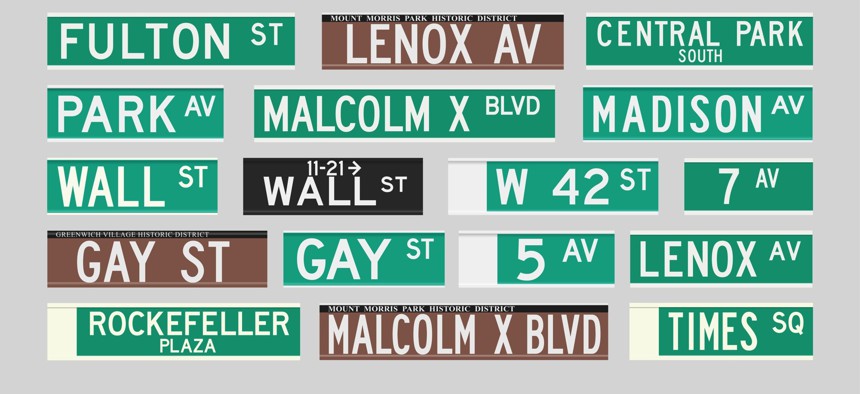When the Soft Power of Naming City Streets Sparks Conflict

Thomas Pajot / Shutterstock.com
From time to time, an ordinarily non-confrontational municipal function can become something very much out of the ordinary.
WASHINGTON — It may seem like a fairly mundane activity within the realm of responsibilities for local officials: Naming streets.
But in some places, officially assigning a name for a stretch of public pavement can become quite controversial.
It all depends on the individual being honored, or, in case the street isn’t being named or renamed for a person, the meaning or symbolism of the name, which might not be immediately apparent.
In the nation’s capital, where members of Congress insert themselves into local District of Columbia matters from time to time, Chinese diplomats have expressed their extreme displeasure over legislation pushed by U.S. senator and Republican presidential candidate Ted Cruz that would rename a portion of the Northwest Washington street outside the Embassy of the People's Republic of China to honor a jailed dissident.
If the stretch of International Place where China’s main diplomatic mission is located were to be renamed Liu Xiaobo Plaza, Beijing has warned of “serious,” though unspecified, consequences, according to The Washington Post.
This effort isn’t new. Reacting to a previous U.S. legislative effort to rename International Place from two years ago, a Chinese embassy spokesman told Al Jazeera America: “This amendment is really absurd.”
Such a passive-aggressive diplomatic street-naming tactic is unlikely to become reality—the White House has said it would veto any renaming bill that would insult the Chinese—but it would not be unprecedented in Washington, D.C.
In the 1980s, a stretch of 16th Street NW between L and M streets, where the primary Soviet Embassy building was located at the time, was renamed for Russian dissident Andrei Sakharov. The address of the Soviet Embassy officially became No. 1 Andrei Sakharov Plaza.
The main Russian diplomatic mission in D.C. has since moved and as Route Fifty discovered Tuesday afternoon, it’s easy to walk by this strange stretch of sidewalk a few blocks from the White House and miss the ceremonial “plaza”—a lone street sign marking Andrei Sakharov Plaza is bent.

In 2005, District residents and local officials fought an ultimately unsuccessful effort by congressional Republicans to rename 16th Street NW in the nation’s capital after the late president, Ronald Reagan.
On the flip side, the District, which lacks full and equal voting representation in Congress, has previously proposed renaming First Street adjacent to the U.S. Supreme Court and U.S. Capitol’s East Front to recognize the federal city’s ongoing disenfranchisement. The “D.C. Taxation Without Representation Way” renaming move by the District government, like the earlier congressional proposal for Ronald Reagan Boulevard, was not successful.
Most U.S. cities, fortunately, don’t have to deal with the geopolitical implications of naming streets to insult other nations or worry about members of Congress intervening in something as mundane as local street naming decisions. But the name that appears on a street sign can become very controversial nonetheless.
In New York City, the borough president for Staten Island, James Oddo, has received a lot of attention recently for his clever way to use his limited powers to express his displeasure over a new housing development built on top of the former Mount Manresa Jesuit Retreat.
Like all borough presidents in New York City, Oddo does not have expansive municipal powers.
Borough presidents were once voting members of New York City’s now-defunct Board of Estimate, a decisionmaking municipal body abolished in August 1990 after a 1989 U.S. Supreme Court ruling that declared the board’s representative structure violated the Fourteenth Amendment’s Equal Protection Clause. (Under the former City Charter, the board had three citywide members—the mayor, comptroller and City Council president—with two votes each, plus the five borough presidents with one vote each. Since borough-by-borough population varied, residents of Brooklyn, the Bronx, Manhattan, Queens and Staten Island did not have equal representation on the citywide Board of Estimate.)
These days, more than a quarter century after the Board of Estimate dissolved, New York City’s borough presidents are mostly ceremonial advocates for their respective jurisdictions. Among their limited official powers, borough presidents appoint members of community boards and, as Oddo reminded the rest of the city, have the responsibility to assign new street names.
In a dense, built-up place like New York City, there aren’t many opportunities to name new streets these days. But the 15-acre Mount Manresa property on Staten Island presented developers with one of the largest parcels of undeveloped land in the city. But many Staten Island residents, including Oddo, had opposed the redevelopment.
When demolition couldn’t be stopped, Oddo decided to use his powers to leave his mark on the new 200-townhome community that took Mount Manresa’s place. Oddo's decision to use his soft powers had a hard-edged purpose. Staten Island’s borough president named the new streets “Cupidity Drive,” “Fourberie Lane” and “Avidita Place.”
What’s wrong with those names?
Cupidity means “lust for wealth.” Avidita is Italian for greed. And Fourberie is French for deceit.
The developer was not pleased with Oddo’s choices and took the matter to court.
"Yes, the borough president has discretion as to what names to give, but that doesn't give him the right to be vindictive, and disparage our client unnecessarily and be spiteful,” a lawyer for the Savo Brothers developers said in December, according to the Staten Island Advance.
But last week, a judge decided that Oddo has the right to select the new street names. Oddo's plan, the judge said, “presumably assumed that these names being easy to pronounce, would be more clearly understood by a 911 dispatcher,” according to the Post.
Michael Grass is Executive Editor for Government Executive’s Route Fifty.
NEXT STORY: Route Fifty’s New E-Book, ‘Budgeting Challenges and Opportunities,’ Is Ready for Download






